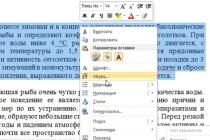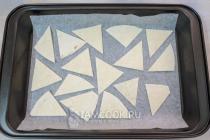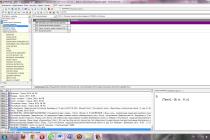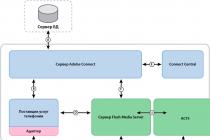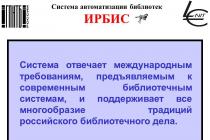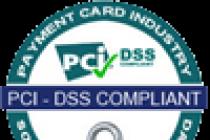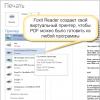As you know, when installing Windows updates, the update files are first downloaded to system folders, and after installing updates ... they remain there. Therefore, the size of the Windows folder is growing all the time. For a year, the folder becomes 6-10 GB fat. The same happens when you install programs whose distribution is made in the form msi file... And this is in addition to the mass of temporary files that are created during installation. I think you know how to delete temporary files.
And how to deal with update files that are not so easy to find and delete manually, and often even impossible, since they are located in protected folders?
Where can I find update files?
All updates for Windows and a number of other programs are delivered to the user on the computer in the form of msi or msp files. After downloading from the Internet, they are stored in the folder C: \ Windows \ SoftwareDistribution \ Download... And after installation, the files necessary for the system are placed in hidden folder "C: \ Windows \ Installer".
The folder C: \ Windows \ SoftwareDistribution \ Download can be cleaned safely manually or by writing simplest file with bat or cmd extension and putting the line in it:
| del c: \ Windows \ SoftwareDistribution \ Download \ *. * / f / s / q |
del c: \ Windows \ SoftwareDistribution \ Download \ *. * / f / s / q
The folder is also growing "C: \ Windows \ Prefetch"... The files that are stored in the prefetch folder contain information about the applications that run on the computer. This information is used by the Prefetch service for more quick launch programs again. If you frequently install and uninstall various programs and applications, the prefetch folder is overflowing with unnecessary information that is no longer used in any way, but simply takes up space on your hard disk. Accordingly, if you delete all the contents of the prefetch folder, then necessary information the programs will be written into it again, and the unnecessary ones will be deleted forever. If you completely delete all files from the prefetch folder, then the first Windows boot 7 after deletion will slow down a little while programs re-enter their data.
vssadmin delete shadows / All / Quiet
The saved bat file with these 3 lines can be connected to the Task Scheduler and run on schedule.
But what about the c: \ Windows \ Installer folder?
As we said, this folder grows as a result of installing programs and updates. And you can't just delete its contents, because some of the data is then used to delete what was installed. But some of the data is useless. For example, some updates are replaced by others, more complete, old ones are no longer needed. How to clean this folder correctly without damaging anything?
I AM long time I use in work unique program PatchCleaner. This utility detects such already unused useless files called orphaned. How does she find them? Using WMI queries to the system, you can get a list of used installers and patches and then compare it with the list of files in the Installer directory.
The utility can be used in the command line mode through the CLI (Command Line Interface). By running the utility with the / d switch, it will automatically detect everything unnecessary and delete such files. As you remember, after installation, you can also add it to the scheduler and run it, for example, once a month after installing updates.
She works great with everyone Windows versions Vista. The only prerequisite for working is the installed .Net Fframework 4.5.2. By the way, the utility has a portable version.
What do not need to be deleted?
Folder C: \ Windows \ WinSxS, or Windows Side by Side, has been present since Windows XP. Microsoft has created a system that allows you to store multiple versions of the same DLLs and use, if necessary, exactly the one required by a particular program. The folder is designed to protect users from the not entirely direct hands of some programmers. When installing, some programs try to replace Windows dll files with their own, which is not always good and can lead to system failure. Microsoft has resolved this issue. Windows directs the dll file of the program to WinSxS, and the program considers that everything is replaced and works quietly. Windows, in turn, also continues to work quietly.
In short, you do not need to delete the contents of this folder. What can you do with it? Yes, Windows 8.1 and newer versions support compressing this folder. How to do this is described in a Microsoft article on TechNet.
WinSxS, or Windows Side by Side, is another new addition to Windows XP. Microsoft has created a system that allows you to store multiple versions of the same DLLs and use, if necessary, exactly the one required by a particular program. The folder is designed to protect users from the not entirely direct hands of some programmers. When installing, some programs try to replace Windows dll files with their own, which is not always good and can lead to system failure. Microsoft has resolved this issue. XP sends the dll-file of the program to WinSxS, and the program considers that everything is replaced and works quietly. Windows, in turn, also continues to work quietly.
Even the most die-hard Windows 7 fans know the odds of seeing Service Pack 2 for the most popular operating system in the world are zero.
Microsoft has no plans to add new features to the operating system and wants it to die when the time comes. Cruel, maybe, but it's reality - Redmond wants all of its users to upgrade to Windows 8 as quickly as possible.
So Windows users 7 must deal with security updates alone.
At the same time, Redmond released a new patch for Windows 7 Service Pack 1, which cleans up Windows file updates and thereby frees up space on local drives.
The idea is not entirely new.
Previously, every time Microsoft released a service pack, it also gave users the option to clean up old Windows updates that were no longer needed. The company has now decided to make this feature available through a dedicated option.
So what does this process look like?
After installing the update, click Start, Search, enter Disk Cleanup and then right click on Disk Cleanup and run it as administrator.
First, you need to select the drive you want to clean up. This is only valid for the operating system disk. So choose C: \.

Disk Cleanup scans and calculates how much space you can free up on this disk:

If you did not run Disk Cleanup as an administrator, then you need to take a couple of additional steps. You have to click on the button Clean up system files.

At this point, Disk Cleanup will resume and you will need to repeat the first two steps again. In order not to waste time, run Disk Cleanup as an admin.
If you review the files to remove, you will see a new option added from this update along with the amount of space that can be saved. It is called Windows Update Cleanup. Note, is it installed by default?
Note: If Windows Update Cleanup does not find anything to clean up, it will not appear as an option.
Important note: After performing this cleanup, you will no longer be able to uninstall any of the updates that are currently involved. However, if you need to roll back to previous version, you can do it manually.

If you highlight Windows Update Cleanup, you will get the following information

"Windows keeps copies of updates from Windows Update, even after installation new version updates. Windows Update cleanup removes old versions of updates that are no longer needed and take up space. (You may need to restart your computer). "
When you click OK, Disk Cleanup starts up and cleans up unnecessary files on your computer. You can see how this happens.

Disk Cleanup finished and exited.
When I tested this update, I was not prompted to restart my computer. However, during the next one you will see that Windows settings started Windows update on shutdown and cleanup on startup.

Cleaning does take a few minutes, so don't be intimidated by this. The more you need to clean, the longer it will take. But even on my machine with 1.78GB of files to clean up, it took 5 minutes.

The amount of space you save will depend on the car, but here's a screenshot with a different example:

How to automate Windows Update Cleanup
I know that out of 10,000 clients, only one wants to do the cleaning himself. So why don't we automate this process?
It's a little cumbersome, but not that bad. First you need to run. That is, to do the export of the registry and the import of such a registry on clients. We can then use cleanmgr.exe (the command line of the Disk Cleanup version) to automate the Windows Update cleanup.
First, a little background. In the next section of the registry, we have a list of all available plugins for Disk Cleanup:
HKEY_LOCAL_MACHINE \ SOFTWARE \ Microsoft \ Windows \ CurrentVersion \ Explorer \ VolumeCaches
Here's an example that this registry key is similar to my Windows 7 SP1 client:

Within each of these plugins there is a value called StateFlags. Here the value is traditionally set to 0 or 1. If it is 1, then it is automatically checked when running Disk Cleanup next time. This is how it looks for the Update Cleanup plugin on my Windows machine 7 SP1:

In order to automate Disk Cleanup with cleanmgr.exe, we need to create a new StateFlags registry for the plugins that we want to automate. So how do we do this?
Open the administrative command line and run the following command:
Cleanmgr.exe / sageset: 11
11 can be any random number between 0 and 65535.
It will look the same as Disk Cleanup works. You will be presented with a disc and options as it was before. When it's done, you can go back to the plugins in the registry and see that there is now a new StateFlags value that matches the number specified with sageset. As an example, here's the same plugin now:

It is important to note that a running sageset does not clean up. It just updates the parameters of this set.
Now that you have this set, you can export the StateFlags registry key for each of the plugins that you would like to automate and import it on another Windows 7 SP1 client. Just make sure to export the StateFlags registry key that was recently added by the sageset command. This will be the one with the number you chose by adding to the ending. In my picture above, this would be StateFlags0011.
After you have exported this key, you can specify Group Policy if you want to use a batch file. The choice is yours.
After importing, you can run cleanmgr.exe / sagerun: 11, which will clean up all of your clients.
Voila! Presto! More free space.
Just like with registry keys, you can schedule a task to then run, say, once a month. However, you need to be very careful. Remember that after performing this cleanup, you will not be able to uninstall the Windows updates that were previously applied. You can still delete Latest updates that were applied after cleaning, although you may be rolled back to SP1. You can also choose not to schedule the task to run immediately after installing updates. Depending on your patching schedule, you can schedule a cleanup in a day or two before regular updates take effect. By default, the option starts the task as soon as possible. If you do not want to run it immediately after applying new updates, I would not recommend checking this box.
Greetings to all users who want to learn more about their computer, Denis Trishkin is with you again.
At some point, many owners of complex computing devices are faced with a situation where they run out of space on system disk... This is due to constant Windows updates, a cluttered desktop, or insufficient initial volume markup. The last problem is solved by increasing the volume. Main screen cleans with your own hands. But how do you uninstall old Windows 7 updates? After all, initially it was impossible to do this. Don't worry - there is a way.
During installation system updates, old files are replaced with new ones and remain on the computer. They can be found in the WinSxS directory, which is located in the Windows folder. This approach allows you to abandon the last add-on at any time, as a result of which the computer will remain fully functional.
But on the other hand, as the OS is constantly updated, the folder grows significantly in size. So, it turns out that what longer Windows installed on the computer, the larger the size of the WinSxS directory. This is of concern to many users, especially those with small system volumes.
From the beginning, Windows did not have built-in uninstall capabilities. So it was necessary to bypass the protection in various "dark" ways and still clear the desired directory.
As a result, Microsoft decided to release the KB2852386 update. It is it that allows you to say goodbye to unused versions of add-ons. This product is the OS Disk Cleanup Wizard and is called the Windows Cleanup Tool.

Important! The update is optional. It is installed on the appropriate tab in the wizard. Alternatively, you can download it manually.
Installation Requirements( )
You need to know that this add-on is only suitable for Windows 7 updated to SP1.
If the utility is downloaded manually from the company's website, users are asked to confirm the authenticity of the OS using programs. If the installation is via built-in capabilities, validation is not performed.
How do I uninstall old updates?( )
The first thing that many people want to know is not even how, but is it possible to delete these files at all? I can safely answer - yes. After all, they are no longer used by the system anyway.
So, to delete unused files from the C drive, you need:

Automate the process across multiple devices( )
If there is a need to carry out this procedure on several devices at once, there is no need to carry out a long list of procedures on each one. You just need to automate the system.
This is done through the registry, which is subject to minor adjustments.

To do this, in: HKEY_LOCAL_MACHINE \ SOFTWARE \ Microsoft \ Windows \ CurrentVersion \ Explorer \ Update Cleanup parameter is created DWORD, to which we assign the value “ 2 "And call StateFlags0022... The last two numbers can be different, the main thing is to remember them.
During the operation of the OS, users notice the rapid growth of the Windows folder. The increase in size is due to the fact that the internal winsxs folder begins to weigh a lot. Let's figure out what this winsxs folder is in Windows 7, 10, 8 and whether it can be deleted or cleaned up.
Winsxs - what is this folder and should it be deleted
This folder is located along the path C: \ Windows \ winsxs and stores the files of the OS components, as well as backups and updates to these files. Even if these components are not installed in operating system, they are stored in the winsxs folder, taking up HDD space.
Note: Under these circumstances, the letter of the local drive is C. Your letter may be different, be careful.
In fact, OS components are in other places, and the contents of the winsxs folder are links to those components. When Windows updates are installed, they and their old copies are deposited in the winsxs folder. Over time, updates become more and more and, accordingly, the winsxs folder takes up a lot of space in Windows.
The winsxs folder can be up to several gigabytes in size. Although for modern hard drives this free space does not mean anything, but it will not be superfluous. To find out how much winsxs weighs, just right-click on it, then select "properties", on the "general" tab, see the number of megabytes. This method will not provide information about the actual size of the folder, but will help judge the amount of free space. Remember this number, it will be needed in the future for comparison. 
Important! It should be noted right away that it makes no sense to manually delete the winsxs folder in Windows in the traditional way, since you can remove the components that are vital for the operation of the system.
Cleaning programs will not work, they remain staff funds OS to help clean up the winsxs folder in Windows. Let's take a closer look at the methods.
Removing old updates through the Disk Cleanup utility
This method works in Windows 7 and later, which will reduce the size of the winsxs folder. Start Disk Cleanup in one of the following ways:

In the new window, click the clear button system files(shown in the screenshot). If appears UAC request click yes. 
To clean the winsxs folder in Windows, make sure that the checkbox next to the "Clean up Windows updates" sub-item is checked, as this section is responsible for deleting files in the winsxs folder. Check other items as you wish. In this window, you can also estimate the approximate amount of free disk space. Finally, click OK and wait for the end of the process, you may need to restart your PC. 
Note: the function of clearing updates is built into windows 8, 10. For the seven, Microsoft released an update for this option to appear. If you do not find the update cleanup point, then download and install the KB2852386 update package. The methods below do not work on Windows 7.
Cleaning with Task Scheduler
With the release of Windows 8, there was a function that allows you to clean the winsxs folder automatically. The OS has created an automatic StartComponentCleanup task that runs in the background to remove old versions of files after 30 days. This period is given to exclude incompatibility of new updates. You can manually start this task by following the steps below.
To start the task scheduler, in the "run" window (called by the Win + R buttons), write the taskschd.msc command, then click OK. 
On the left side of the window, expand the Task Scheduler Library section, then the Microsoft and Windows subsections, find the Servicing section and click it. Select StartComponentCleanup, on the right side of the window, click "Run" to start cleaning the winsxs folder. You need to wait about an hour. 
Note: you can accomplish this task through the command line. You must then use the command:
schtasks.exe / Run / TN "\ Microsoft \ Windows \ Servicing \ StartComponentCleanup"
Cleaning up through the command line
Dism.exe is a cmd application that allows you to perform various manipulations with Windows components, which will help you clean up the winsxs folder. Windows 10, 8.1 introduced the new AnalyzeComponentStore parameter to help determine how much space the winsxs pack actually takes up. Bring up the command line with administrator rights, enter the following command and click Enter:
Dism.exe / Online / Cleanup-Image / AnalyzeComponentStore
As a result of the calculations, you will know if cleaning is recommended. To see the amount of memory that can be freed, take a look at the items marked in the screenshot. The sum of these two elements shows the amount of used hard disk space. 
After analysis, you can start cleaning the winsxs folder. The StartComponentCleanup parameter in cmd produces similar results as in Task Scheduler. However, the removal of components occurs immediately, without waiting. In cmd with admin rights, enter this construction, then click Enter:
Dism.exe / online / Cleanup-Image / StartComponentCleanup
Using the ResetBase parameter you remove all obsolete versions of each component. The command looks like this:
Dism.exe / online / Cleanup-Image / StartComponentCleanup / ResetBase
The SPSuperseded setting helps reduce the space that the service pack takes up. Use a command like this:
Dism.exe / online / Cleanup-Image / SPSuperseded
Wait for the completion of these commands. Next, estimate the amount of freed memory using the AnalyzeComponentStore parameter. 
Removing Windows Components
Windows 8, 10 allow you to enable, disable Windows components. These functions are located in the "Programs" section. 
Everything Windows components are stored in the winsxs folder, whether enabled or not, and take up space. There is a way to help remove these components from winsxs entirely, thereby freeing up space. In the future, you will be able to download the remote components as needed.
Run cmd with admin privileges. Enter the command below, then press Enter:
DISM.exe / Online / English / Get-Features / Format: Table

The command line will build a table of component names, as well as their states. Remember the name of the component to be removed and use the following command:
DISM.exe / Online / Disable-Feature / featurename: NAME / Remove
In this command, you need to replace NAME with the name of your component. In the example, we will remove DirectPlay. 
This will change the status to Disabled with Payload Removed. In these ways you can clear the winsxs folder in Windows.
That's all, now you know winsxs - what is this Windows folder 7, 8, 10 and how to clean it. It is recommended to use the first three methods first, although you do not need to resort to the method with the task scheduler, since it is duplicated, but everything is at your discretion. Removing the components is not recommended because it will not free up much space, and the removed components may be needed in the future. You can also, to free up additional space on the HDD.

